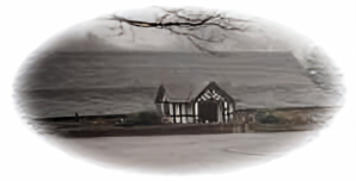© www.white-coppice.co.uk 2022

Rivington
is a village in the Borough of Chorley... Rivington is three miles south east of Chorley, and is popular with the people of Chorley, Horwich and Bolton. At the turn of the 20th Century Lord Leverhulme (who created Lever soaps and Port Sunlight) built a bungalow of wooden construction just below Rivington Pike and set about having the whole of the hillside almost down to Rivington Hall Barn landscaped. Although he succeeded with his gardens - he was not so lucky with his house - which was set alight by a suffragette. Leverhulme built a second home, this time of masonry, which survived until the February of 1948 when it was demolished. All that remains of the house are some neatly laid black and white chequered floor tiles in the grass. The gardens have faired a little better, and it is these that attract many people to the area. The stone summer houses, bridges and step ways are in good condition and provide excellent pathways through the rhododendrons to the Dovecote (the tower that can be seen to the left of the Pike) and Rivington Pike. It is hard to imagine now that the hills above Rivington were once a hive of industry, but they were. The hills in this area were extensively mined, and Winter Hill and it's slopes, are riddled with tunnels and shafts, but all the entrances have been filled in now and so there is little sign of mining activities. Mining took place on Winter Hill as late as 1961.The other main industry was quarrying, and there are several disused quarries in the area. Far below, Rivington and some of the reservoirs can be seen. In fact, approaching Rivington from Chorley, the road goes across a causeway which separates Upper Rivington and Lower Rivington reservoirs. There are five reservoirs in the area and they were mostly built in the 1850's by Liverpool Corporation, but one by the name of High Bullough (which is the oldest) was built by Chorley Corporation. In their day they were the most modern in the country. They were designed so that each flowed into the next and water was only taken from the last one (Lower Rivington) and piped 25 miles to Liverpool. Rivington is also famous for its two Anglo-Saxon barns, Hall Barn being the larger and situated near the Rivington Hall. Great House Barn is half a mile away and is now a tea room and gift shop. Adjacent to it is an information centre. The whole area is maintained by United Utilities and there are miles of footpaths both leisurely and strenuous.
Lord Leverhulme’s bungalow.
Note the lawn and the
gardener. The steps (far right
are still there to day)



















